Serena Younes
The Democratic People’s Republic of Korea, also known as North Korea, has been ruled by the Kim family since the very beginning of their existence. Their three generation dictatorship started at Kim Il Sung [Kim Ilseung], to his son Kim Jong Il [Kim Jong-il], then to present day ruler Kim Jong Un [Kim Jong-eun].[1] The name states “Democratic People’s Republic,” however the dynasty they have created is completely different. This country is not in any way like a democracy.
Kim Il Sung (ruled 1948-1994)
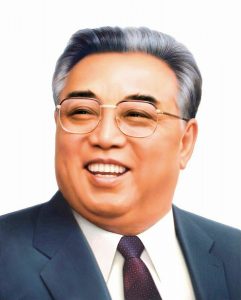
Kim Il Sung, also known as “the Great Leader,” was North Korea’s first leader and was the world’s longest ruling leader of his time.[2] Originally North Korea was a communist state, modeled on Marxist and Leninist theories. The Juche ideology created by Kim transformed Koreas idea of policies away from Marx’ and Lenin’s ideas. Juche emphasizes the importance of self reliance and independence for North Korea. The government and citizens follow the Juche ideology and it is heavily promoted by propaganda.[3]
Kim began his military career at age twenty in the Korean Revolutionary Army (1932/1933). Kim’s small troop was broken up by the Japanese, with Kim’s leader captured and sent to prison. Kim avoided being sent to prison and continued on with another small troop. He eventually became the leader of his own band of soldiers. He had military training at a camp near Khabarovsk, Russia and during this time he and his wife had their first child, Kim Jong Il, at one of the camps. In North Korea propaganda after the war, Kim Il Sung became widely known as a brave Korean fighter who emerged victorious. But, he was only a bit better known than other soldiers in the war because he was captured yet not imprisoned by the Japanese, making the Russians choose him for the founding of North Korea. In August of 1945 the Japanese surrendered and one month later in September Kim arrived in Korea by boat as a captain in the Soviet army. It was an astonishing sight, since during the war Kim kept his political beliefs low. Kim was appointed by the Russians to lead the Provisional People’s Committee in 1946 to bring various political groups to the Committee. The Korean Workers’ Party was inaugurated in 1946, and although Russia supported Kim he was not elected chairman, but instead was a vice chairman. By 1949, Kim had built up his political position, pushing his way into becoming the chairman and remained in that position until his death in 1994. In 1950 with the support of Joseph Stalin and Mao Zedong, Kim initiated the Korean War. Kim was failing in this war and was to blame everyone but himself. Kim, in defeat, needed the help of the Chinese and they took over the military strategy for the rest of the war. After the war, Kim named himself victorious over the Americans and South Koreans. He took full government control, removing all of his political opponents. During the 1970s Kim Il Sung’s son, Kim Jong Il, gradually started to take over issues.[4] By this time, Kim’s personality cult was well past the size of Stalin’s or Mao’s.[5] Kim Il Sung was still active in the government until he had a heart attack in 1994 and passed away.[6]
Kim Jong Il (ruled 1994-2011)
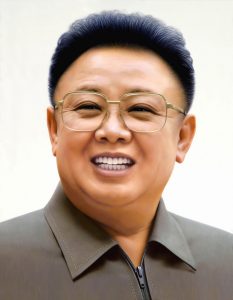
After the mournful death of “The Great Leader,” his son Kim Jong Il took over. Kim Jong Il was known as “Dear Leader.”[7] He was born at a military camp in Russia, but North Korea propaganda says he was born at Mount Paekdu [Baekdu], which is Korea’s highest and most sacred mountain. It was said that when he came into the world, a new star appeared in the sky, a double rainbow appeared, an iceberg on a lake cracked, and lights filled the sky. Till this day no one knows what actually happened during his birth, but to North Koreans it inspires the civilians and builds onto his personality cult. It is in Korean tradition to have myths about the leaders. Kim Jong Il attended the Political Economy Department of Kim Il Sung University. He was very well liked and treated with a very high level of respect by the faculty because of his bloodline to the Kim family.[8]
In 1973, Kim was appointed to the Politburo and named the director of the Organization and Guidance Department as well as “the leader of the party and the people”. In 1974, Kim came out with the “Ten Principles” saying that society is unified in using Juche ideology and that everyone is obedient to “the Great Leader” Kim Il Sung.[9] After his father’s death in 1994, he became general secretary of the Korean Workers’ Party (KWP), leaving the role of Eternal President to his deceased father. It was rumored and believed that many of the military hierarchy were not in support of Kim Jong Il becoming the highest leader. He was the youngest member of the KWP Politburo and was known as being very indecisive. Kim kept a low profile after his fathers death.[10] The North Korean media continuously described how much Kim worked for the Korean people.[11] He helped more with the economy in North Korea, rather than being involved in the army.[12] North Koreans say he went through so much for the people and would rather take care of his civilians rather than his own health, and also that he understands what they are going through and all the hardships.[13] Kim Jong Il claims to understand the hardships, however he focused more on the economy rather than helping people while they were starving to death. Many people were dying from illnesses and he was focused on smaller issues. Many that know him would describe Kim Jong Il to be short tempered, strong, demanding, and ruthless when people question his beliefs or policies.[14] Over his twenty years of ruling, he did not speak in public, and so the people did not hear their leader’s voice. In 2011, Kim Jong-Il died from a heart attack supposedly from being overworked. This was expected based on his history of smoking, drinking, and family heart issues.[15]
Kim Jong Un (ruled 2011-present)
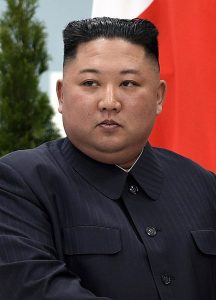
After Kim Jong Il’s death in 2011, Kim Jong Un immediately closed the country’s borders and called a state of emergency. Kim Jong Un quickly came to power and North Korea made it well known. Because Kim Jong Un had no leadership experience or training like his father Kim Jong Il did, North Korea watchers were worried about the instability of Kim rising to leadership, and that it could ultimately trigger the collapse of North Korea. North Korea previously had famines and the country was very poor and the people still did not have food. If he followed Korean tradition, Kim Jong Il would have named Kim Jong-nam his successor since he was the oldest. Kim Jong Il did not want that, claiming Jong-nam was “tainted by foreign influence.” He has also been detained in Japan with a fake passport when he tried to go to Tokyo Disneyland. The second oldest son, Kim Jong-chul was very kind and would not have the power to harm a soul. Kim Jong-un was chosen since he was aggressive. In the years immediately after he came to power, he transformed many aspects of North Korean policies. First, he continued his fathers mission in carrying out nuclear tests and over 90 ballistic missiles to provide North Korea with protection. Despite the economic instability and financial debt North Korea is in, Kim Jong-un chooses to focus on transforming his country into a nuclear armed state. Kim made it clear that he will not denuclearize North Korea, and he sees nuclear weapons as vital for the security of the country. Kim is not afraid of any threats: he intentionally killed his half brother, Kim Jong-nam, at an airport with a chemical nerve agent. He also executed his uncle for undermining his leadership. Kim also created a massive army which is now one of the largest in the world.[16]
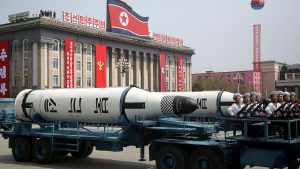
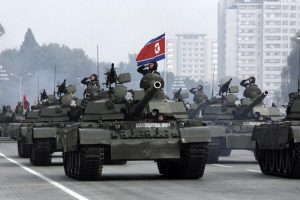

Kim Jong Un built many ski resorts and high end restaurants to showcase a false image to outsiders that the country is prospering. He has committed multiple human rights violations according to the U.N. Commission of Inquiry on Human Rights. One of these include having prison camps with terrible treatments such as beatings, forced labor, and rape. The regime “seeks to dominate every aspect of its citizens’ lives and terrorizes them from within.”[17] Kim seems to demonstrate and emphasize to the public a better standard of life with more flow of goods into the country. This is not the case however, since the only people able to access these goods are elites. Anyone who engages in political opposition to the government gets executed or severely punished. North Korea has been extremely isolated from the entire world for its whole existence, so many/most North Koreans do not have any idea of what life is like for anyone on the outside.[18] The leaders of North Korea keep the country so isolated because they do not want others to see the failed country and additionally for the North Koreans to be able to see the outside world. North Korea can’t support itself. There is not always electricity, and it is very out of date with technology. The industry is very far behind as well.[19] There is a high percentage of suicide, illness from stress, starvation related deaths, and alcoholism within the people of North Korea.[20]
Life in a Totalitarian State
North Korea has a totalitarian communist dictatorship, which means the government is in control of everything. The government controls all the media such as the radio, television, newspapers, and the very limited internet access. Additionally, the government is in control of the careers citizens take by assigning them based on rankings. Permission is needed to travel outside your home region and it is restricted to travel outside of the country. The social classification of residents is determined by their loyalty to the Kim regime. This is beyond being loyal to the Kim regime, this includes your whole family history of loyalty to the regime. The citizens are put through a background check called songbun. Loyalty surveys are also regularly distributed to create a class structure. Kim’s goal was to create a structure that placed him at the top with three broad categories: the core class, the wavering class, and the hostile class. The core class includes the military and the people in the government, and they live luxuriously. The wavering class has factory workers and farmers. Lastly the hostile class includes anyone that is suspected of being disloyal to the party.[21]
Conclusion
The dangerous and closed-off Democratic People’s Republic of Korea continues to violate human rights, and this has continued under its different leaders. North Koreans live in the past and there is no escape from this dictatorship. Juche and ideas of self-reliance have transformed North Korea into a terrifying threat to every other country in the world. Its leaders have become legitimized and continue to strengthen their military force.
Bibliography
French, Paul. North Korea: State of Paranoia. London: Zed Books, 2015. http://ebookcentral.proquest.com/lib/muhlenberg/detail.action?docID=2146957.
“North Korea.” Accessed February 27, 2022. https://web-s-ebscohost-com.muhlenberg.idm.oclc.org/ehost/ebookviewer/ebook/bmxlYmtfXzU0NDU2Nl9fQU41?sid=26984f3f-f48f-45b1-856a-57602f1db485@redis&vid=0&format=EB&rid=1.
Oh, Kongdan, and Ralph C. Hassig. North Korea through the Looking Glass. Brookings Institution Press, 2000. http://www.jstor.org/stable/10.7864/j.ctvdmx00c.8.
Pak, Jung H. The Education of Kim Jong-Un. Washington: Brookings Institution Press, 2018. http://muse.jhu.edu/book/57780.
- This chapter provides between [square brackets] the transcription in Revised Romanization used in South Korea and the rest of this textbook, but the chapter uses the commonly used North Korean transcription. ↵
- Kongdan Oh and Ralph C. Hassig, “The Leader, His Party, and His People,” in North Korea through the Looking Glass (Brookings Institution Press, 2000), 81. ↵
- “North Korea,” accessed February 27, 2022, https://web-s-ebscohost-com.muhlenberg.idm.oclc.org/ehost/ebookviewer/ebook/bmxlYmtfXzU0NDU2Nl9fQU41?sid=26984f3f-f48f-45b1-856a-57602f1db485@redis&vid=0&format=EB&rid=1. ↵
- Kongdan Oh and Ralph C. Hassig, North Korea through the Looking Glass, 81-85. ↵
- Paul French, North Korea: State of Paranoia (London: Zed Books, 2015), 84. ↵
- Oh and Hassig, North Korea through the Looking Glass, 85. ↵
- Oh and Hassig, North Korea through the Looking Glass, 85. ↵
- French, North Korea: State of Paranoia, 88. ↵
- Oh and Hassig, North Korea through the Looking Glass, 87. ↵
- French, North Korea: State of Paranoia, 91. ↵
- “North Korea,” accessed February 27, 2022, https://web-s-ebscohost-com.muhlenberg.idm.oclc.org/ehost/ebookviewer/ebook/bmxlYmtfXzU0NDU2Nl9fQU41?sid=26984f3f-f48f-45b1-856a-57602f1db485@redis&vid=0&format=EB&rid=1. ↵
- French, North Korea: State of Paranoia, 96. ↵
- Oh and Hassig, North Korea through the Looking Glass, 98-99. ↵
- French, North Korea: State of Paranoia, 94. ↵
- Jung H. Pak, The Education of Kim Jong-Un (Washington: Brookings Institution Press, 2018), 3. ↵
- Pak, The Education of Kim Jong-Un, 7-14. ↵
- Pak, The Education of Kim Jong-Un, 5, 14. ↵
- French, North Korea: State of Paranoia, . ↵
- Oh and Hassig, North Korea through the Looking Glass, 176-77; French, North Korea: State of Paranoia, 417-18. ↵
- French, North Korea: State of Paranoia, 418. ↵
- “North Korea,” accessed May 8, 2022, https://web-p-ebscohost-com.muhlenberg.idm.oclc.org/ehost/ebookviewer/ebook/bmxlYmtfXzU0NDU2Nl9fQU41?sid=2a7ea25f-fb5e-4bbc-9df6-3568f122d776@redis&vid=0&format=EB&rid=1. ↵
